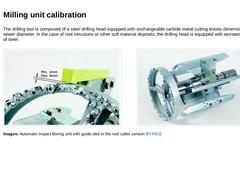
|
The drilling tool is composed of a steel drilling head equipped with exchangeable carbide metal cutting knives dimensioned to the sewer diameter. In the case of root intrusions or other soft material deposits, the drilling head is equipped with serrated knives made of steel. (Image: Milling head calibration for a DN 200/300 pipe) (Image: Milling unit for a DN 200/300 pipe) Images: Automatic Impact Boring unit with guide sled in the root cutter version [… |
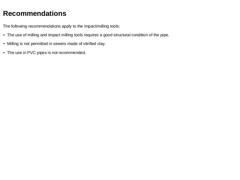
|
The following recommendations apply to the impact/milling tools: -
The use of milling and impact milling tools requires a good structural condition of the pipe.
-
Milling is not permitted in sewers made of vitrified clay.
-
The use in PVC pipes is not recommended.
|
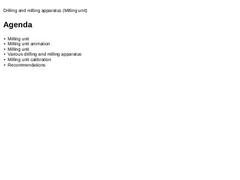
|
|
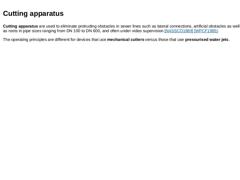
|
Cutting apparatus are used to eliminate protruding obstacles in sewer lines such as lateral connections, artificial obstacles as well as roots in pipe sizes ranging from DN 100 to DN 600, and often under video supervision [NASSCO1989] [WPCF1985]. The operating principles are different for devices that use mechanical cutters versus those that use pressurised water jets.
|
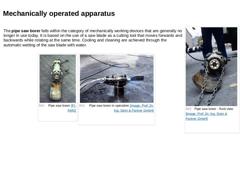
|
|
The pipe saw borer falls within the category of mechanically working devices that are generally no longer in use today. It is based on the use of a saw blade as a cutting tool that moves forwards and backwards while rotating at the same time. Cooling and cleaning are achieved through the automatic wetting of the saw blade with water. |
(Image: Pipe saw borer - front view) |
|
(Image: Pipe saw borer) |
(Image: Pipe saw borer in operation) |
|
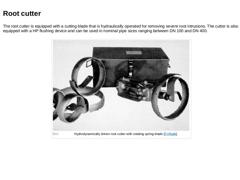
|
The root cutter is equipped with a cutting blade that is hydraulically operated for removing severe root intrusions. The cutter is also equipped with a HP flushing device and can be used in nominal pipe sizes ranging between DN 100 and DN 400.
(Image: Hydrodynamically driven root cutter with rotating spring blade) |
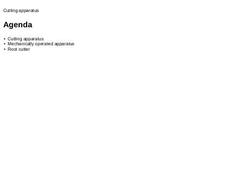
|
|
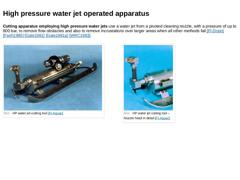
|
Cutting apparatus employing high pressure water jets use a water jet from a pivoted cleaning nozzle, with a pressure of up to 800 bar, to remove flow obstacles and also to remove incrustations over larger areas when all other methods fail [FI-Drain] [Fairh1985] [Gale1981] [Gale1981a] [WRC1983]. (Image: HP water jet-cutting tool) (Image: HP water jet cutting tool – Nozzle head in detail) |

|
In close co-operation with the University of Hannover, Germany, the company KEG GmbH [FI-KEG] has developed a system for Abrasive waterjet cutting in non-accessible sewers. The system is able to remove obstacles that are impeding the flow in the pipe (e.g. protruding pipe connections, bricks, steel rods) and/or hose liners. This is achieved using relatively low pressures of only 100 – 120 bar. (Image: IPEK FW 125 with abrasive waterjet cutting) |
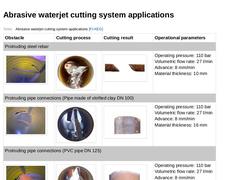
|
(Table: Abrasive waterjet cutting system applications) |

|
|
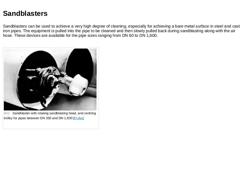
|
Sandblasters can be used to achieve a very high degree of cleaning, especially for achieving a bare metal surface in steel and cast iron pipes. The equipment is pulled into the pipe to be cleaned and then slowly pulled back during sandblasting along with the air hose. These devices are available for the pipe sizes ranging from DN 60 to DN 1,600. (Image: Sandblaster with rotating sandblasting head, and centring trolley for pipes between DN 350 and … |
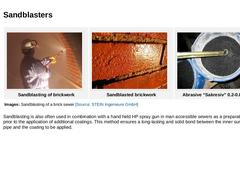
|
|
(Image: Sandblasting of the brickwork)Sandblasting of brickwork |
(Image: Sandblasted brickwork)Sandblasted brickwork |
(Image: Strahlmittel Sakresiv 0,2 - 0,8 mm)Abrasive “Sakresiv” 0.2-0.8 mm |
|
Images: Sandblasting of a brick sewer [Image: Prof. Dr. Ing. Stein & Partner GmbH] |
Sandblasting is also often used in combination with a hand held HP spray gun in man accessible sewers as a preparatory measure prior to the application of additional coatings. … |
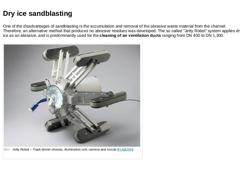
|
One of the disadvantages of sandblasting is the accumulation and removal of the abrasive waste material from the channel. Therefore, an alternative method that produces no abrasive residues was developed. The so called “Jetty Robot” system applies dry ice as an abrasive, and is predominantly used for the cleaning of air ventilation ducts ranging from DN 400 to DN 1,300. (Image: Jetty Robot – Track-driven chassis, illumination unit, camera and nozzle) |

|
|
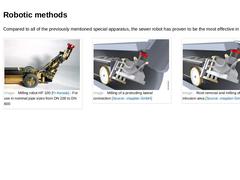
|
Compared to all of the previously mentioned special apparatus, the sewer robot has proven to be the most effective in practice. (Image: Milling robot HF 100 [FI-Kanala] - For use in nominal pipe sizes from DN 200 to DN 600) (Image: Milling of a protruding lateral connection) (Image: Root removal and milling of the intrusion area) |
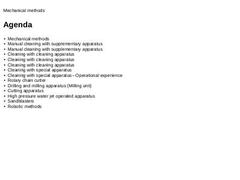
|
|
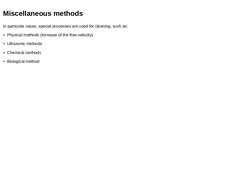
|
In particular cases, special processes are used for cleaning, such as: |
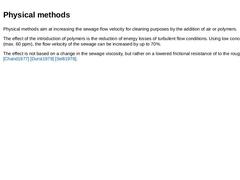
|
Physical methods aim at increasing the sewage flow velocity for cleaning purposes by the addition of air or polymers. The effect of the introduction of polymers is the reduction of energy losses of turbulent flow conditions. Using low concentrations (max. 60 ppm), the flow velocity of the sewage can be increased by up to 70%. The effect is not based on a change in the sewage viscosity, but rather on a lowered frictional resistance of to the rough pipe … |
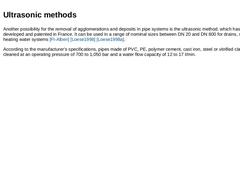
|
Another possibility for the removal of agglomerations and deposits in pipe systems is the ultrasonic method, which has been developed and patented in France. It can be used in a range of nominal sizes between DN 20 and DN 600 for drains, sewers and heating water systems [FI-Alben] [Loese1998] [Loese1998a]. According to the manufacturer’s specifications, pipes made of PVC, PE, polymer cement, cast iron, steel or vitrified clay can be cleaned at an … |
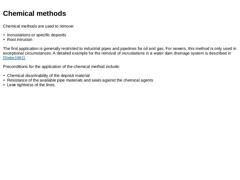
|
Chemical methods are used to remove: -
Incrustations or specific deposits
-
Root intrusion
The first application is generally restricted to industrial pipes and pipelines for oil and gas. For sewers, this method is only used in exceptional circumstances. A detailed example for the removal of incrustations in a water dam drainage system is described in [Siebe1981]. Preconditions for the application of the chemical method include: -
Chemical dissolvability …
|
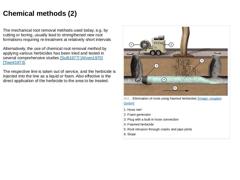
|
The mechanical root removal methods used today, e.g. by cutting or boring, usually lead to strengthened new root formations requiring re-treatment at relatively short intervals Alternatively, the use of chemical root removal method by applying various herbicides has been tried and tested in several comprehensive studies [Sulli1977] [Ahren1970] [Townl1973]. The respective line is taken out of service, and the herbicide is injected into the line as a … |
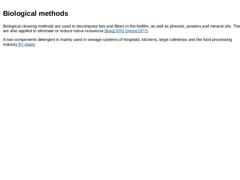
|
Biological cleaning methods are used to decompose fats and fibres in the biofilm, as well as phenols, proteins and mineral oils. They are also applied to eliminate or reduce odour nuisances [Baig1976] [Jense1977]. A two-components detergent is mainly used in sewage systems of hospitals, kitchens, large cafeterias and the food processing industry [FI-Aladi].
|
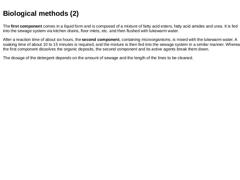
|
The first component comes in a liquid form and is composed of a mixture of fatty acid esters, fatty acid amides and urea. It is fed into the sewage system via kitchen drains, floor inlets, etc. and then flushed with lukewarm water. After a reaction time of about six hours, the second component, containing microorganisms, is mixed with the lukewarm water. A soaking time of about 10 to 15 minutes is required, and the mixture is then fed into the sewage … |

|
|